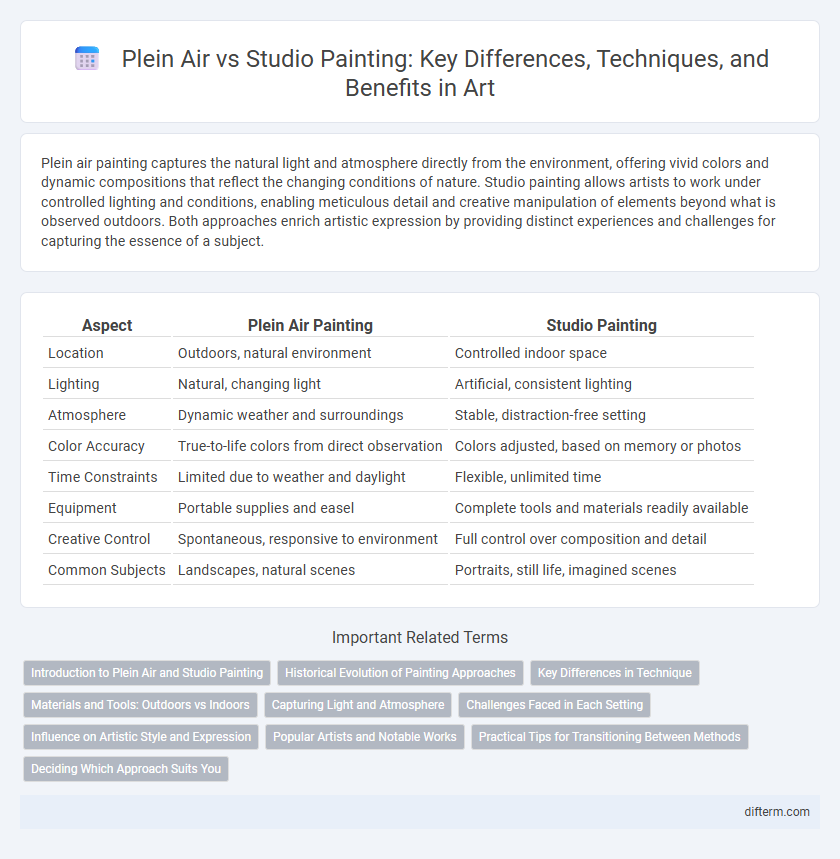Plein air painting captures the natural light and atmosphere directly from the environment, offering vivid colors and dynamic compositions that reflect the changing conditions of nature. Studio painting allows artists to work under controlled lighting and conditions, enabling meticulous detail and creative manipulation of elements beyond what is observed outdoors. Both approaches enrich artistic expression by providing distinct experiences and challenges for capturing the essence of a subject.
Table of Comparison
| Aspect | Plein Air Painting | Studio Painting |
|---|---|---|
| Location | Outdoors, natural environment | Controlled indoor space |
| Lighting | Natural, changing light | Artificial, consistent lighting |
| Atmosphere | Dynamic weather and surroundings | Stable, distraction-free setting |
| Color Accuracy | True-to-life colors from direct observation | Colors adjusted, based on memory or photos |
| Time Constraints | Limited due to weather and daylight | Flexible, unlimited time |
| Equipment | Portable supplies and easel | Complete tools and materials readily available |
| Creative Control | Spontaneous, responsive to environment | Full control over composition and detail |
| Common Subjects | Landscapes, natural scenes | Portraits, still life, imagined scenes |
Introduction to Plein Air and Studio Painting
Plein air painting involves creating artwork outdoors to capture natural light, atmosphere, and color directly from the environment, emphasizing spontaneity and immediate observation. Studio painting allows artists to work in a controlled indoor space, enabling detailed compositional planning, experimentation with materials, and refinement over time. Both approaches contribute uniquely to artistic expression, with plein air fostering dynamic realism and studio painting supporting complex, layered techniques.
Historical Evolution of Painting Approaches
Plein air painting, emerging prominently in the 19th century with the Impressionist movement, emphasized capturing natural light and atmospheric conditions directly from outdoor settings, revolutionizing artistic techniques and perspectives. Studio painting, dominant in earlier periods such as the Renaissance and Baroque, prioritized meticulous composition and controlled environments, enabling artists to refine details and idealize subjects. The historical evolution from studio to plein air approaches reflects broader shifts in art toward realism, spontaneity, and the exploration of transient effects in nature.
Key Differences in Technique
Plein air painting emphasizes capturing natural light, color variations, and atmospheric conditions directly on location, requiring rapid brushwork and adaptable techniques to respond to changing environments. Studio painting allows for controlled lighting, detailed layering, and precise manipulation of composition without environmental constraints. These differences shape how artists approach texture, color mixing, and brushstroke application, influencing the overall mood and immediacy of the artwork.
Materials and Tools: Outdoors vs Indoors
Plein air painting requires portable, lightweight materials such as compact easels, travel-friendly palettes, and quick-drying acrylics or watercolors to adapt to changing outdoor conditions. Studio painting allows for a broader range of tools including larger canvases, heavy easels, and oil paints that necessitate controlled environments and longer drying times. Natural light outdoors influences color mixing techniques, while artificial studio lighting enables precise control over shading and detail.
Capturing Light and Atmosphere
Plein air painting excels in capturing the fleeting light and atmospheric nuances of a specific moment, enhancing color vibrancy and natural shadows through direct observation. Studio painting allows for controlled manipulation of light sources and atmosphere, enabling artists to refine mood and detail with precision. Mastery of both approaches enriches an artist's ability to convey realistic or expressive environments in their work.
Challenges Faced in Each Setting
Plein air painting demands artists to adapt quickly to changing light, weather conditions, and environmental distractions, which can disrupt concentration and alter color perception. Studio painting offers controlled lighting and consistent conditions but often struggles with capturing the spontaneity and atmosphere that outdoor settings provide. Both environments require distinct techniques to manage challenges such as rapid drying times outdoors and lack of natural ambiance indoors.
Influence on Artistic Style and Expression
Plein air painting captures natural light and atmosphere, resulting in dynamic brushstrokes and vibrant color palettes that reflect immediate surroundings and fleeting conditions. Studio painting allows for controlled environments and detailed work, enabling artists to refine techniques and explore complex compositions over extended periods. The choice between plein air and studio significantly influences artistic style, with plein air emphasizing spontaneity and emotion, while studio work often favors precision and conceptual depth.
Popular Artists and Notable Works
Claude Monet's "Impression, Sunrise" and Camille Pissarro's "The Boulevard Montmartre on a Winter Morning" exemplify the spontaneity and vibrant light characteristic of plein air painting. In contrast, studio painters like Johannes Vermeer, with "Girl with a Pearl Earring," emphasize controlled composition and refined detail achieved through careful planning. The dynamic interplay between natural light observations in plein air and meticulous studio techniques highlights distinct artistic approaches influencing the evolution of modern art.
Practical Tips for Transitioning Between Methods
Mastering plein air painting requires portable, lightweight supplies and quick drying mediums to handle changing outdoor conditions, while studio painting benefits from controlled lighting and extended working time. Transitioning between methods involves adapting brush techniques to capture fleeting light outdoors and refining details indoors with slow-drying oils or acrylics. Practical tips include organizing dual palettes, layering applications for depth, and using reference photos to bridge the dynamic outdoor scene with detailed indoor work.
Deciding Which Approach Suits You
Plein air painting immerses artists in natural light and landscapes, fostering spontaneity and authentic color perception, which benefits those who thrive on direct observation and dynamic environments. Studio painting allows precise control over composition, lighting, and technique, ideal for artists who prefer meticulous planning and refinement away from external variables. Choosing between plein air and studio approaches depends on your creative workflow, patience for environmental challenges, and desire for immediacy versus detailed craftsmanship.
plein air vs studio painting Infographic

 difterm.com
difterm.com